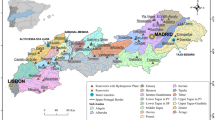Abstract
Mathematical models are tools that can facilitate the instrumentation of the Integrated Water Resources Management (IWRM). The first basin models to be developed were completely hydrological; today, due to the urgent need to plan the sustainable use of water resources, new models are needed that in addition to hydrology also incorporate social, economic, legal, environmental and other aspects. The objective of this work was to identify the characteristics that mathematical basin models must have in order to satisfy the requirements of IWRM. To achieve this, the conclusions of the main international conferences on water and the environment were analyzed; these were conferences in which IWRM was promoted as a strategy to face the challenges of both sectors. IWRM considers social participation as a key element in the decision-making process; consequently, the models must be accepted and applied, and their results interpreted, by those who participate in the process even if they are not modelling experts. This requires a change of perspective in the scientific community for the development of new IWRM models, in government institutions regarding their role as water administrators, and in water stakeholders regarding their role as decision-makers. The results of the analysis indicate that models for IWRM must be accessible to non-expert users, integrate different viewpoints, representing adequately the problem to be solved, in addition be flexible and have a structure focused on practical solutions.
Similar content being viewed by others
References
Ahuja LR, Ascough JC, David O (2005) Developing natural resource models using the object modeling system: feasibility and challenges. Adv Geosciences 4:29–36
Bay-Delta Modeling Forum (BDMF) (2000) Protocols for water and environmental modeling. Ad hoc modeling protocols committee, California water and environmental modeling forum. http://cwemf.org/Pubs/Protocols2000-01.pdf. Accessed 11 Feb 2006
Berger T, Birner R, Díaz J, McCarthy N, Wittmer H (2007) Capturing the complexity of water uses and water users within a multi-agent framework. Water Resour Manag 21:129–148
Beven K (1989) Changing ideas in hydrology—the case of physically-based models. J Hydrol 105(1/2):157–172
Beven KJ (2001) How far can we go in distributed hydrological modeling? Hydrol Earth Syst Sci 5(1):1–12
Blind M, Gregersen JB (2005) Towards an open modelling interface (OpenMI) the HarmonIT project. Adv Geosciences 4:69–74
Bonell M (2004) How do we move from ideas to actión? The role of the HELP programme. Water Resour Dev 20(3):283–296
Comisión Nacional del Agua (CNA) (2000) Reglamento del Distrito de Riego 005, Delicias. Gerencia Estatal Chihuahua, Chihuahua
Croke BFW, Ticehurst JL, Letcher RA, Newham LTH, Jakeman AJ (2007) Integrated assessment of water resources: Australian experiences. Water Resour Manag 21:351–373
International Conference on Water and Environment (ICWE) (1992) The Dublin statement on water and sustainable development, 31 de Enero de 1992. http://www.inpim.org/files/Documents/DublinStatmt.pdf. Accessed 8 Jan 2007
Falkenmark M, Gottschalk L, Lundqvist J, Wouters P (2004) Towards integrated catchment management: increasing the dialogue between scientists, policy-makers and stakeholders. Water Resour Dev 20(3):297–309
Global Water Partnership (GWP) (2004) Catalyzing change: a handbook for developing integrated water resources management (IWRM) and water efficiency strategies. http://www.gwpforum.org/gwp/library/Handbook.pdf. Accessed 22 Mar 2006
Global Water Partnership (GWP) (2006) Setting the stage for change, second informal survey by GWP network giving the status of the 2005 WSSD target on national integrated water resources management and water efficiency plans. http://www.gwpforum.org/gwp/library/IWRMSurvey-final.pdf. Accessed 22 Mar 2006
Global Water Partnership-Technical Committee (GWP-TEC) (2004) Integrated water resources management (IWRM) and water efficiency plans by 2005, why, what and how? TEC, Stockholm, TEC Background Papers No. 10
Heinz I, Pulido-Velazquez M, Lund JR, Andreu J (2007) Hydro-economic modeling in river basin management: implications and applications for the European water framework directive. Water Resour Dev 21:1103–1125
Koutsoyiannis D, Karavokiros G, Efstratiadis A, Mamassis N, Koukouvinos A, Christofides A (2003) A decision support system for the management of the water resources system of Athens. Phys Chem Earth 28:599–609
Kralisch S, Krause P, David O (2005) Using the object modeling system for hydrological model development and application. Adv Geosci 4:75–81
Krause P, Kralisch S, Flügel WA (2005) Preface, Model integration and development of modular modeling systems. Adv Geosci 4:1–2
Lanini S, Courtosis N, Giraud F, Petit V, Rinaudo JD (2004) Socio-hydrosystem modeling for integrated water-resources management—the Hérault catchment case study, Southern France. Environ Model Softw 19:1011–1019
Olsson JA, Anderson L (2007) Possibilities and problems with the use of models as a communication tool in water resources management. Water Resour Manag 21:97–110
Rahaman MM, Varis O, Kajander T (2004) EU water framework directive vs. integrated water resources management: the seven mismatches. Water Resour Dev 20(4):565–575
Red Internacional para el Desarrollo de Capacidades en la Gestión Integrada del Recurso Hídrico (CapNet) y Global Water Partnership (GWP) (2005) Planes de Gestión Integrada del Recurso Hídrico, Manual de capacitación y guía operacional. http://www.gwpforum.org/gwp/library/IWRM_manual_Spanish.pdf. Accessed 22 Mar 2006
Singh VP, Woolhiser DA (2002) Mathematical modeling of watershed hydrology. J Hydrol Eng 7(4):270–292
Sokrut N (2004) Distributed hydrological modeling: myth or reality? http://www.lwr.kth.se/Forskarutbildning/markovatten/1B5629/Distributed%20hydrological%20modelling.pdf 7 Feb 2006
World Water Council-Comisión Nacional del Agua (WWC-CNA) (2006a) Eje Temático 1. Agua para el Crecimiento y Desarrollo. Documentos Temáticos, IV Foro Mundial del Agua. WWC-CAN, México
World Water Council-Comisión Nacional del Agua (WWC-CNA) (2006b) Eje Temático 2. Agua para el Crecimiento y Desarrollo. Documentos Temáticos, IV Foro Mundial del Agua. WWC-CAN, México
Volk M, Hirschfeld J, Schmidt G, Bohn C, Dehnhardt A, Liersch S, Lymburner L (2007) A SDSS-based ecological-economic modelling approach for integrated river basin management on different scale levels-the project FLUMAGIS. Water Resour Manag 21:2049–2061
Xu C-Y (2002a) Modelling in hydrology. In: Uppsala University (ed) Hydrologic models, text book. Uppsala University, Uppsala
Xu C-Y (2002b) Runoff in hydrologic models. In: Uppsala University (ed) Hydrologic models, text book. Uppsala University, Uppsala
Author information
Authors and Affiliations
Corresponding author
Rights and permissions
About this article
Cite this article
Silva-Hidalgo, H., Martín-Domínguez, I.R., Alarcón-Herrera, M.T. et al. Mathematical Modelling for the Integrated Management of Water Resources in Hydrological Basins. Water Resour Manage 23, 721–730 (2009). https://doi.org/10.1007/s11269-008-9296-y
Received:
Accepted:
Published:
Issue Date:
DOI: https://doi.org/10.1007/s11269-008-9296-y




